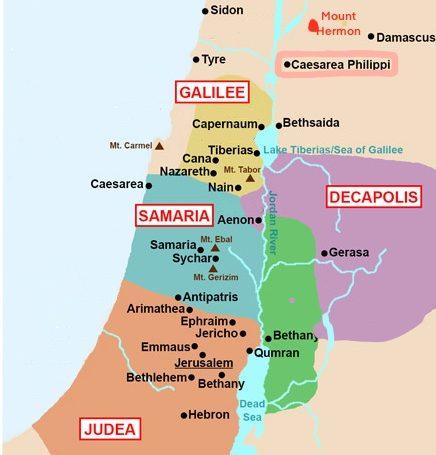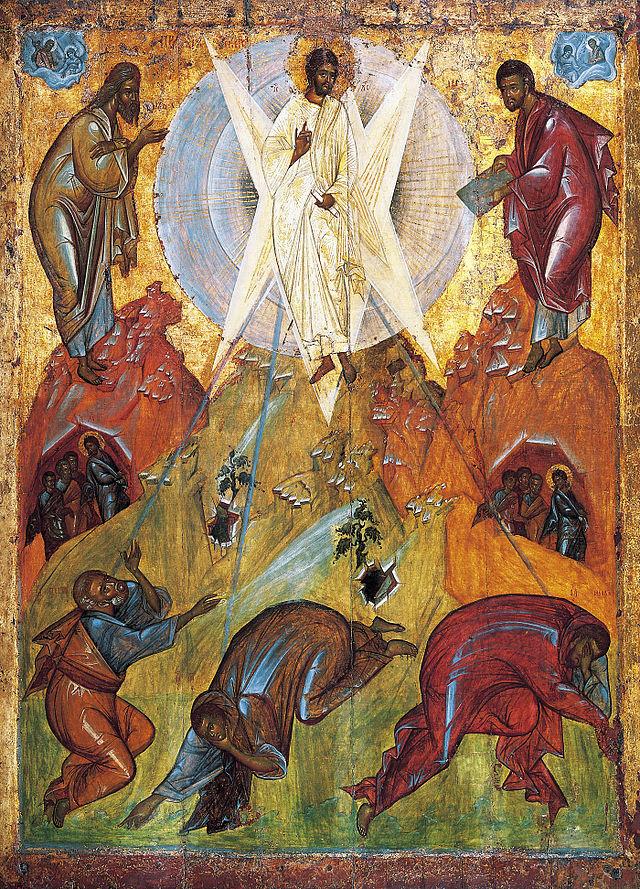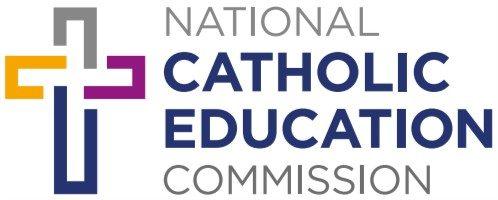The Transfiguration
2 Six days later, Jesus took with him Peter and James and John, and led them up a high mountain apart, by themselves. And he was transfigured before them, 3 and his clothes became dazzling white, such as no one on earth could bleach them. 4 And there appeared to them Elijah with Moses, who were talking with Jesus. 5 Then Peter said to Jesus, “Rabbi, it is good for us to be here; let us make three dwellings, one for you, one for Moses, and one for Elijah.” 6 He did not know what to say, for they were terrified. 7 Then a cloud overshadowed them, and from the cloud there came a voice, “This is my Son, the Beloved; listen to him!” 8 Suddenly when they looked around, they saw no one with them any more, but only Jesus.
The Coming of Elijah
9 As they were coming down the mountain, he ordered them to tell no one about what they had seen, until after the Son of Man had risen from the dead. 10 So they kept the matter to themselves, questioning what this rising from the dead could mean. 11 Then they asked him, “Why do the scribes say that Elijah must come first?” 12 He said to them, “Elijah is indeed coming first to restore all things. How then is it written about the Son of Man, that he is to go through many sufferings and be treated with contempt? 13 But I tell you that Elijah has come, and they did to him whatever they pleased, as it is written about him.”
New Revised Standard Version Bible: Catholic Edition, copyright © 1989, 1993 the Division of Christian Education of the National Council of the Churches of Christ in the United States of America. Used by permission. All rights reserved.
What to do with this educator’s commentary
This commentary invites you as a teacher to engage with and interpret the passage. Allow the text to speak first. The commentary suggests that you ask yourself various questions that will aid your interpretation. They will help you answer for yourself the question in the last words of the text: ‘what does this mean?’
This educator’s commentary is not a ‘finished package’. It is for your engagement with the text. You then go on to plan how you enable your students to work with the text.
Both you and your students are the agents of interpretation. The ‘Worlds of the Text’ offer a structure, a conversation between the worlds of the author and the setting of the text; the world of the text; and the world of reader. In your personal reflection and in your teaching all three worlds should be integrated as they rely on each other.
In your teaching you are encouraged to ask your students to engage with the text in a dialogical way, to explore and interpret it, to share their own interpretation and to listen to that of others before they engage with the way the text might relate to a topic or unit of work being studied.
Structure of the commentary:
Text & textual features
Characters & setting
Ideas / phrases / concepts
Questions for the teacher
The world in front of the text
Questions for the teacher
Meaning for today / challenges
Church interpretations & usage
The World Behind the Text
See general introduction to Mark.
The World of the Text
Text & Textual Features
This passage occurs just after the halfway point of the gospel of Mark. In the previous chapter Jesus and his disciples have gone to Caesarea Philippi, a Greco-Roman city at the base of Mount Hermon where pagan gods were worshipped.

At Caesarea Philippi (Mark 8: 27-38), Jesus had asked the disciples, “Who do you say I am?” Peter identifies Jesus as the Messiah and for the first time in the gospel, Jesus teaches that the Messiah must suffer and die. Peter protests at this and is rebuked by Jesus. Jesus then goes on to say that discipleship involves self-denial and picking up the cross and those who lose their life for his sake will save it.
Six days later, Jesus takes Peter, James and John with him. It is notable that these three are chosen for this experience. They form a ‘ring’ among the twelve, closer to Jesus than the others (see characters).
On ‘a high mountain apart’ Jesus is revealed as God’s son, the beloved, and the command is given to ‘listen to him’. This is the second of three episodes in the gospel of Mark where Jesus is declared to be God’s son. Techniques Mark uses at the baptism of Jesus, (dialogue, heavenly allusions) the first of these three, are recognisable in this passage.
The presence of Elijah and Moses, both highly important Old Testament figures, is highly symbolic; Mark recalls their own encounters with God on Mt Sinai/Horeb, with Jesus’ one now. Jesus comes in a long line of those whose experience with God affirms their role in salvation history.
The effect of the vision on Peter has him awkwardly suggesting the building of three dwellings – one for Jesus, one for Moses and one for Elijah, and the disciples being terrified. At the conclusion of the vision, the disciples see only Jesus. Moses and Elijah have gone: Jesus stands as the fulfilment of the law and the prophets.
As Jesus and the disciples come down the mountain Jesus tells the disciples to ‘tell no one’ about what they have experienced until after the Son of Man has risen from the dead. This is a common feature of the gospel of Mark with Jesus frequently telling the disciples not to talk to anyone about his identity. Usually called the ‘Messianic secret’, scholars wonder at its inclusion in Mark’s writing. Does Jesus tell the disciples not to speak of events to highlight that, in fact, they will? In their grappling with what has happened, the disciples recall the Jewish tradition of Elijah returning to earth before the Messiah. Jesus tells the disciples that Elijah has already come, attributing this role to John the Baptist.
The Transfiguration in the gospel of Mark draws from Exodus 24: 9-18, in that episode Moses brings his ‘apprentice’ Joshua with him up to the top of Mt Sinai to meet God.
Characters & Setting:
Jesus
Prior to this episode Jesus has been identified by Peter as the Messiah. In this event Peter identifies Jesus as ‘Rabbi’ (see Ideas/Phrases/Concepts). God, through a voice from a cloud, confirms that Jesus is the Son of God, the Beloved. Jesus appears transfigured with clothes of dazzling white. In Greek the word ‘morphE‘ indicating that the inner person has been outwardly revealed. That the clothes, which appear as whiter than anyone on earth could bleach them, indicates the work of the divine.
Peter, James and John
The inner circle of Peter, James and John are present as a group at three significant episodes in Mark’s gospel. They are present at the raising of Jairus’ daughter (Mark 5: 21-43). Jesus allows no one to follow him (Mark 5: 37) except these three disciples when he goes to heal the girl. Peter, James and John are also the disciples Jesus takes with him when he prays at Gethesame (Mark 14: 33). Scholars speculate at the choice of these three disciples at the Transfiguration. Are they brought to the mountain because of their understanding or lack of it? Does Mark imply that surely with this experience they will know how jesus is? Peter’s reaction indicates that this does not happen: they do not understand their experience.
After Jesus’ death and resurrection, they will go on to be key leaders of the community, but at this stage have notmade the link between suffering and resurrection. The Transfiguration in the gospel of Mark also alludes to Exodus 24: 9-18, in that as Moses brought his ‘apprentice’ Joshua with him up to the top of Mt Sinai to meet God, Jesus now brings Peter, James and John with him.
Elijah and Moses
Elijah and Moses represent the Law (Moses) and the Prophets (Elijah, although Moses was also a prophet). While Moses is the most significant figure in the Old Testament, in the gospel of Mark the convention appears to be to mention the most important person second.
Both figures are notable for their interactions with God on mountains (Moses, Exodus 24: 9-18 and Elijah, 1 Kings 19: 8-18) and for the unusualness of their ‘deaths’ with Moses being buried by God and none of the Israelites knowing the place of his burial (Deuteronomy 34: 5-6) and Elijah ascending to heaven in a fiery chariot in a whirlwind (2 Kings 2:11). Both men suffered for their fidelity to God.
Voice from the cloud
The voice in the cloud is identifiable as God. God was present in the cloud that led the Israelites through the desert (Exodus 13:21) and a cloud signified the presence of God in the Temple (1 Kings 8: 10) This is the second time in the gospel of Mark that the voice of God is heard from a cloud, the first being the baptism of Jesus (Mark 1: 9-11). In the first episode Jesus hears the voice, ‘You are my Son, the Beloved; with you I am well pleased (v. 11). Now the voice is speaking to the disciples identifying Jesus as God’s son, the Beloved, and insistent that the disciples listen to him.
Setting:
The writer of Mark does not specify the location of ‘the high mountain’. There are traditions of it either being Mt Hermon, the highest mountain in Israel and a short distance from the setting of the previous episode in Mark’s gospel at Caesarea Philippi (modern day Banias) or Mt Tabor, which centres the story in Galilee. Both locations show evidence of buildings being on their summits at the time of Jesus. The setting of the story is therefore more likely to be symbolic, linking it to the encounters of Elijah (1 Kings 19: 8- 18) and Moses (Exodus 24: 9-18) with God on Mt Sinai/Mt Horeb. In many cultures, mountains are seen as places of communication with divine beings.
The timing of the story is less than a week after Jesus’ question – ‘Who do you say I am?’ and Peter’s declaration that Jesus is the Messiah (Mark 8: 29). This is a turning point in Mark’s gospel where Jesus faces the reality of his own impending death and warns the disciples that there will be suffering in the journey of discipleship.
Ideas/Phrases/Concepts:
Six days later
The time frame of ‘six days later’ has been given a number of interpretations. Some scholars see it as indicating the seventh day, the Sabbath, the Lord’s day. Others suggest that as six is one less than seven, the number of wholeness in the Jewish tradition, this indicates that the revelation that occurs through the transfiguration experience is incomplete. However, many interpret the time frame as a further allusion to Exodus 24: 9-18 when God invites Moses to come up Mt Sinai to meet God. Moses spends six days on the mountain with his assistant Joshua, on the seventh day, God calls to Moses from the cloud that covered the mountain.
Mountain
In many cultures, mountains are places where the divine can be experienced. In this text the mountain is ‘apart’. It is unclear whether it is a mountain that stands alone from others or it is a place where Jesus and Peter, James and John can be away from the ordinary everyday to experience the divine. The presence of Elijah and Moses in this text alludes to their experiences of theophany (appearance of God) on mountains. Moses encounters God on Mt Sinai (Exodus 24: 9-16) and Elijah on Mt Horeb/Sinai (1 Kings 19: 8-18)
Transfiguration
‘Trans’ is a preposition indicating a bridge across or through and ‘figure’ relates to the human body. The writer of Mark’s gospel uses the transfiguration of Jesus to convey a truth about him – his full identity and role. This would have been reassuring for Mark’s community who were suffering and asking the question of ‘Who do you say I am?’ for themselves.
Rabbi
Peter had identified Jesus as the Messiah in Mark 8:29 but in this next episode, in his confusion and terror he identifies Jesus as ‘Rabbi’. At the time of writing of Mark’s gospel it was probably not a term for a Jewish teacher but had evolved to this by the time of the writing of the gospel of Matthew. The meaning in Mark’s gospel is ‘my great one’ or ‘my Lord’.
Dwellings
In the NRSVCE translation of this text, Peter’s strange response to the vision of Jesus dressed in dazzling white and talking to Elijah and Moses, is to suggest the building of dwellings. Other translations of this text describe the constructions as shelters, tents, booths or tabernacles. Pater’s suggestion recalls the Feast of Tabernacles (Sukkot) which takes place six days after the Day of Atonement, which commemorates God’s giving of the Covenant on Mt Sinai.
Beloved
This name is given to Jesus by God on two occasions- at Jesus’ baptism (Mark 1:11) and at the transfiguration (Mark 9:7). As this is a title bestowed by God, it should be considered more than titles others give to Jesus.
Son of Man
The voice from the cloud (God) identifies Jesus as ‘my Son, the Beloved’ (Mark 9: 7). In Mark 9: 9, the writer of Mark has Jesus self-identify as ‘Son of Man’. This is a common self-identification by Jesus across the gospels which suggests it was one of the sayings of the historical Jesus. Scholars link this to references in the Book of Daniel, one of the apocalyptic books of the Bible. An episode in Daniel 10 (Daniel 10: 5-6) has Daniel witnessing a vision of a man clothed in linen and with a ‘face like lightning’.
Risen from the dead
At the time of Jesus some groups believed that the resurrection of the body would happen for the righteous at the end of time. Jesus’ order that the disciples should tell no one about the transfiguration experience until after the Son of Man had risen from the dead (Mark 9: 9) has the disciples questioning what this could mean. The text indicates that it is only after Jesus’ suffering and death that the disciples are able to make sense.
Questions for the teacher:
The World in the Front of the Text
Questions for the teacher:
Meaning for today/challenges
The writer of the gospel of Mark wrote his gospel to persuade a community. They were in need of reassurance that they were making the right choice to follow Jesus when the likely outcome was suffering and death. For disciples today who may also ask the question, ‘Who do you say I am?’ the Transfiguration text can also be reassuring and call believers into a deeper relationship with Jesus as the Son of God, the Beloved. At the end of the revelatory vision on the mountain, Peter, James and John see ‘only Jesus’ (Mark 9: 8) and they have been commanded to ‘listen to him’ (Mark 9: 7). This is to be their focus. For believers today, Jesus is also their focus and there is an assertion to deepen their commitment to discipleship even if it leads to suffering.
The journey for Peter, James and John, of confusion about what is happening to one of the closeness of God is also encouraging. Intimacy, knowing is possible after periods of confusion, remoteness and doubt. For disciples today this message may be heartening. On the journey of faith there maybe moments when the glory of God is experienced, this can happen for those who are ‘listening’.
This reading is the Gospel for the first Sunday in Advent. Advent is often a happy and exciting time; it is a time when anticipation of an event is heralded as we look forward to the promised of Christmas and the coming of the Messiah – Jesus’ birth. Advent is a time for hope. The placing of this Gospel at the beginning of Advent challenges listeners to be ready: although we might know the date of Christmas, the day on which God comes into our lives – in a myriad of forms – is not known: we must be ready and ‘keep awake’ lest we miss it.
Church interpretation and usage
In homilies about the Transfiguration, Pope Francis has emphasised the importance of listening to Jesus as the voice from the cloud (God) commanded. Pope Francis has also reflected on the ascent and descent up the mountain as contemplation and action.* He equated the ascent up the mountain as making time and space to be with God in prayer and that this is important to provide inspiration to descend from the mountain and engage in mission.
*http://www.vatican.va/content/francesco/en/angelus/2014/documents/papa-francesco_angelus_20140316.html

Liturgical Usage
Mark 9: 2- 10 is used liturgically on the Second Sunday of Lent, Year B. The accompanying readings are Genesis 22:1-2, 9-13, 15-18 where Abraham prepares to sacrifice Isaac on a mountain; Psalm 115:10, 15-19; and Romans 8: 31-34. The Second Sunday of Lent always features an account of the Transfiguration with Matthew 17:1-9 used in Year A and Luke 9: 28-36 used in Year C. The first reading on the Second Sunday is always from the story of Abraham (Year A- Genesis 12: 1-4 The call of Abraham, Year C- Genesis 15: 5-12, 17-18 The covenant with Abraham). The coupling of the Transfiguration with a story from the Abraham saga can be considered as a sign of hope in Lent, God can transform and give meaning to our lives even when they may appear to be pointless or we are encountering great suffering.
